Charged With Battery
Upgrading your RV's battery bank to Lithium batteries
Article Date: March, 2023
Article by Mark Quasius
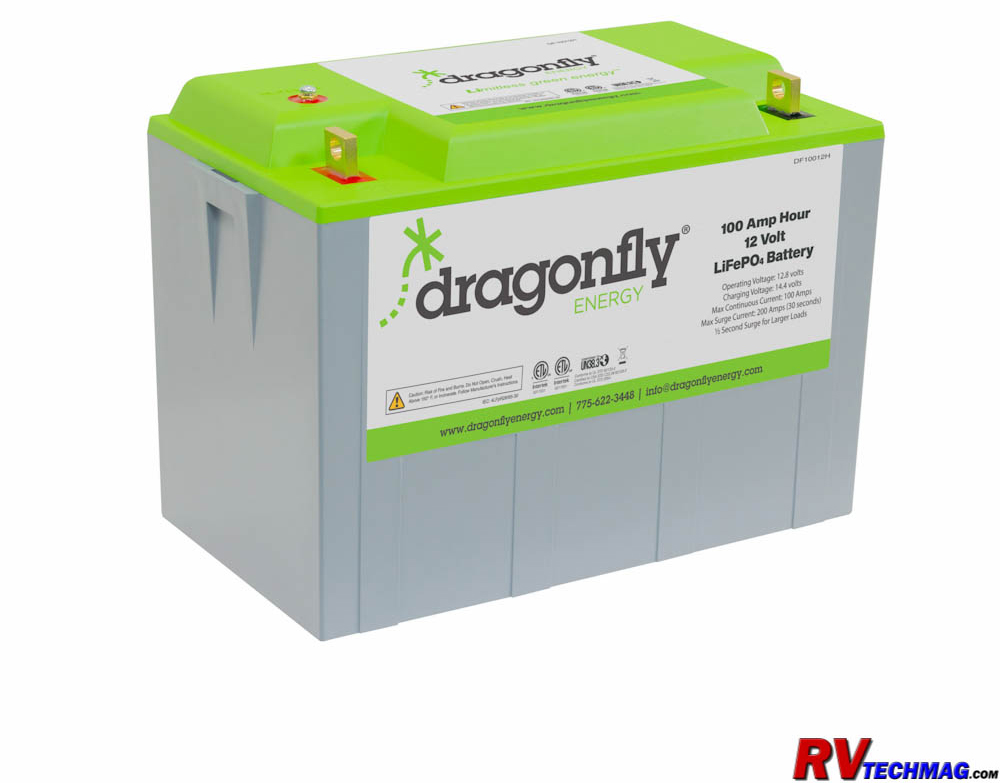
Lithium batteries are the latest greatest thing in battery technology. Lithium batteries first
became popular in video camcorders due to their benefits over NiCad batteries. They are now being used in EV vehicles
and are seeing adoption into recreational vehicles. Their biggest claim to fame is by packing more energy into a smaller
sized package - something every RV owner can use. However, this isn't the typical RV upgrade where you simply buy the
batteries and swap them out with your old lead-acid batteries. There's more to it than that and a few things you need to know
beforehand, which is what this article will hopefully help you to better understand.
Early Fears
You've undoubtedly heard stories of lithium batteries suddenly igniting and creating fires. In
the early days of Lithium-ion batteries this did happen but Lithium Phosphate (LiFePO4) batteries offer a superior chemical and
mechanical structure that does not overheat to unsafe levels. LiFePO4 batteries have similar states when charged or discharged
which allows the ions to remain stable. Lithium-ion batteries with a cobalt-oxide bond will break down if overcharged and the
battery overheats and can experience thermal runaway. Lithium-Phosphate cathode chemistry won't do that and the cells are
incombustible so there is no chance of harm if you experience a crash or short circuit in the battery buss with LiFePO4 batteries.
Battery Chemistry
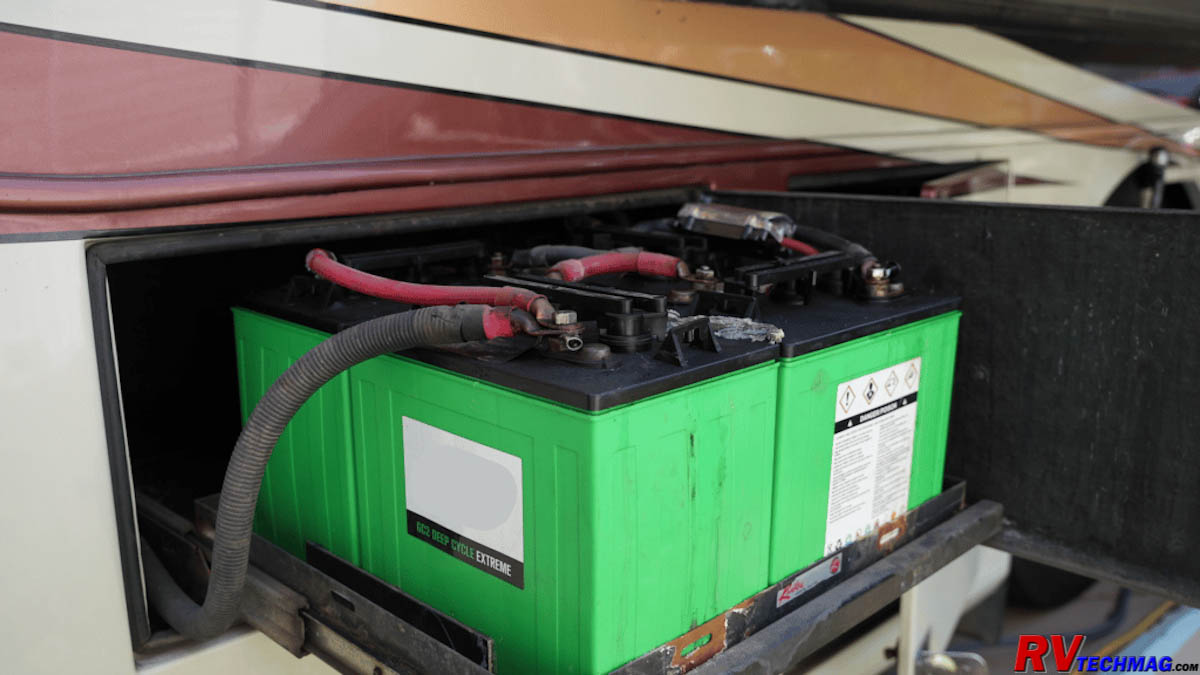
A typical bank of four 6 volt lead-acid batteries
A battery doesn't "make" electricity. It "stores" it internally until you use it. This means you have to put
some into the battery before you can take some out, just like putting gasoline into a car before setting out on a trip. Technically it
"converts" an incoming electrical charge to chemical energy in the electrolyte. When you want to draw power out the chemical energy
converts back to electrical energy by changing the potential energy in the electrolyte to electrical energy. When the potential energy
in the electrolyte is depleted you basically have a dead battery. Recharging that battery will restore the potential energy to the
electrolyte and you're back in business again.
Lead-acid batteries use lead plates submerged inside an electrolyte and are commonly available in two
types - flooded and AGM. Flooded batteries have been used in vehicles since the beginning. A sulphuric acid solution is poured into
the battery cells to fully cover the lead plates. As the battery discharges it gradually turns the sulphuric acid into water and
deposits phosphates on the battery plates. When the battery is recharged the phosphate recombines with the
electrolyte to restore its
potential energy. If the charge voltage is too high it can cause outgassing of hydrogen, which is why flooded batteries must be kept in
a vented compartment away from any electrical components that could cause a spark. This can also deplete the water level in the battery,
requiring close monitoring of your battery's electrolyte level and topping of with distilled water in necessary.
|
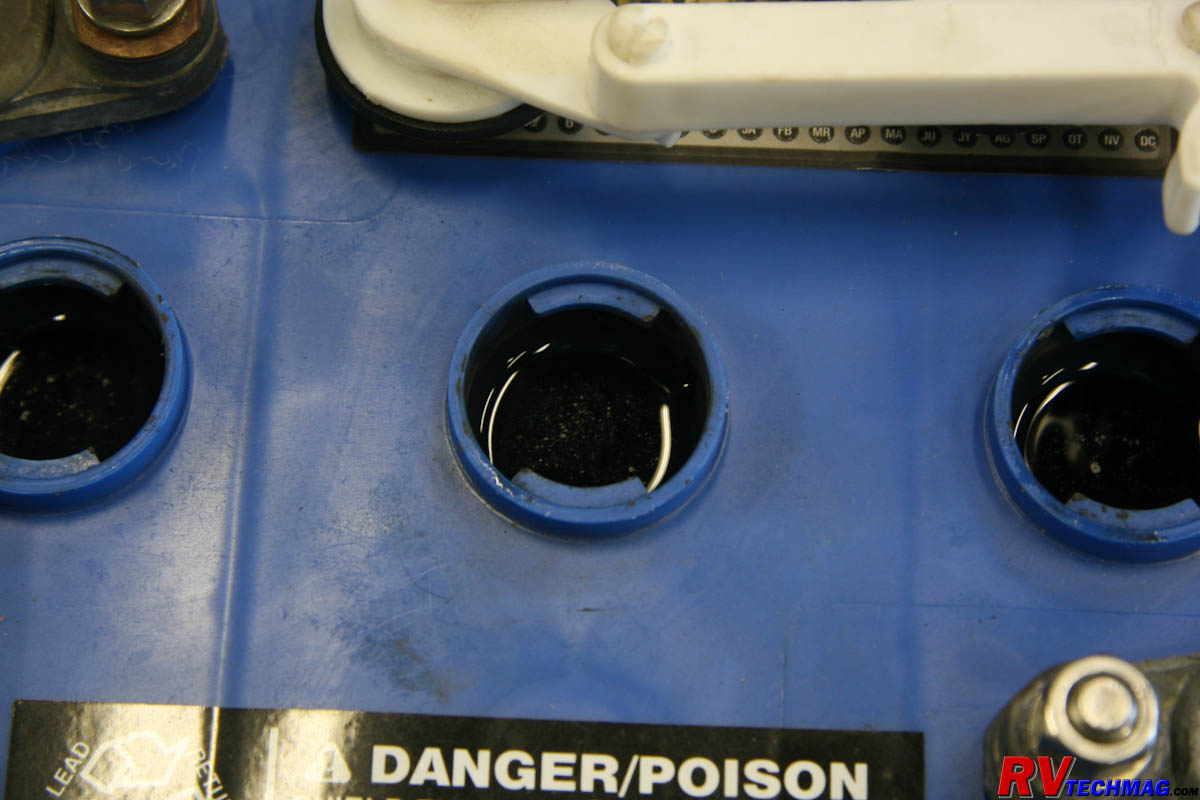
Flooded batteries require constant maintenance to maintain the proper electrolyte level.
|

A refractometer is used to verify the state of charge of a flooded battery.
|
AGM batteries the are next step up in technology. AGM stands for Absorbed Glass Mat and is still a lead-acid battery
but differs from flooded batteries in a significant way. In this case the electrolyte isn't a liquid acid. Instead it's a gel form of
electrolyte that is impregnated into a fiberglass mat that is wrapped around the lead battery plate. This eliminates having to worry
about having to add water to your batteries. It basically a sealed battery that doesn't
outgas hydrogen. Technically it does because
the battery cells are vented to allow for thermal expansion but these vents have valves and any venting is minute enough that the concern
about explosive gasses in microscopic. The only advantage that flooded batteries have is their cost, because AGM batteries are more
expensive than flooded batteries.
Lithium phosphate batteries are sealed units, similar to an AGM, that use lithium-phosphate as the cathode and
carbon as the anode. The electrolyte is a lithium salt in an organic solvent.
Benefits of Lithium-ion Batteries
The real question here is "Why do I want Lithium batteries?". Well, maybe you don't. Lithium batteries have a ton
of benefits but they are a significant upcharge over flooded or AGM batteries. If you generally drive a bit then spend your days and nights
at a campground with full hookups you may have trouble justifying the benefits versus cost. On the other hand, if you do extensive dry
camping without hookups you may find them indispensable. Most RV owners fall somewhere between these two extremes.
Lithium batteries deliver more amp-hour capacity than a lead acid battery of similar size. Typically you will require
twice the physical space to create a given battery bank with flooded batteries versus lithium batteries. By upgrading to lithium you will
either gain some additional space or utilize the same space but double the capacity of your battery bank. Another factor is weight. Large
battery banks can affect axle weights. Lithium batteries typically weigh about half of lead-acid batteries so you'll recover some extra
cargo carrying capacity due to the reduced weight. You'll even reduce the weight even further if you only use one half of the batteries that
you needed to achieve the same amp-hour rating with lead-acid batteries.
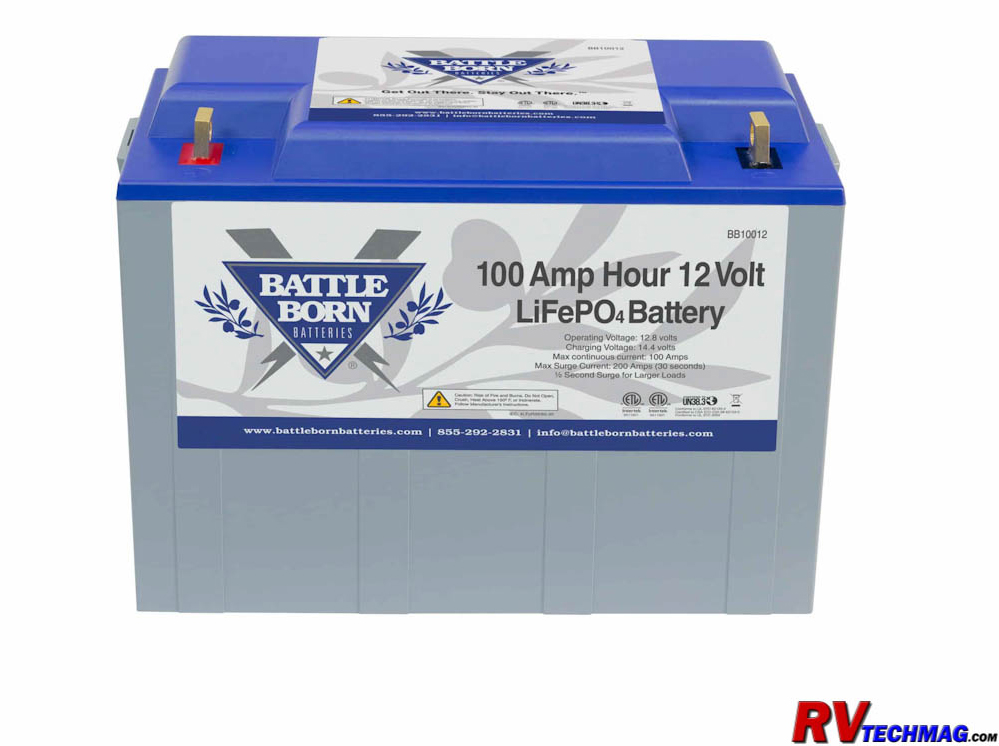
A lithium battery will deliver twice the amp-hours of a lead-acid
battery at 1/2 the weight.
There is one other factor that is a big benefit with lithium batteries. A lead-acid battery should not be discharged
below 50% or else the battery life is greatly shortened. When the battery is being used to power devices the voltage drops. By the time 50% of
the amp-hours are gone the remaining voltage will be too low to safely operate your 12 volt equipment. Therefore a 12 volt battery with
a 100 amp-hour rating is really only capable of safely providing 50 amp-hours of current. A lithium battery rated at 100 amp-hours will provide
the full capacity of 100 amp-hrs. Lithium batteries hold their voltage level strong until the very end, at which time the voltage drops off
sharply.
To put it in perspective, a lead-acid battery bank of four 220 amp-hour 6 volt golf cart style batteries will be rated
at 440 amp-hours at 12 volts and weigh approximately 264 lbs. Because you can only access 50% of that your true usable capacity is 220 amp-hours.
A lithium battery bank of four similar sized 100 amp-hour 12 volt batteries will take up the same physical space as the four 6 volt lead-acid
batteries at only 124 lbs. of weight and will deliver a usable capacity of 400 amp-hrs. You are basically getting double the amp-hrs for the same
physical space and less than one half of the weight. If you don't need all of that capacity you can scale back to two lithium batteries and gain
some additional space and save an additional 62 lbs. of weight.
Longevity is another benefit to Lithium batteries. AGM batteries generally last a bit longer than flooded batteries but even
AGMs are expected to have a 5 year lifespan or 500 charge and discharge cycles. Lithium batteries are expected to last more than 3,000 charge and
discharge cycles. This is a factor to consider when comparing the cost between AGM batteries that will need to be replaced after 5 years versus the
3,000 - 5,000 cycle expected life of a lithium battery, which may never require replacement unless you keep your RV a very longtime.
|
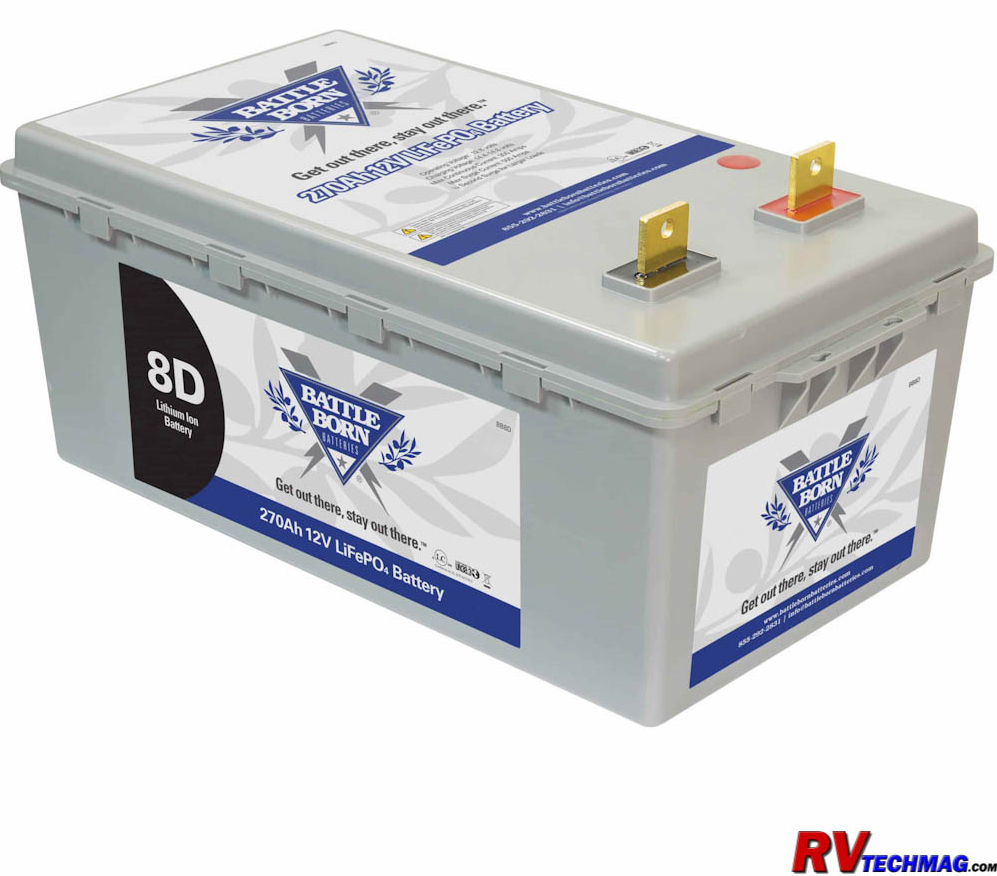
A single large group 8D lithium battery can deliver 270 amp-hours of power, equal to 4-6 golf cart style 6 volt lead-acid batteries.
|
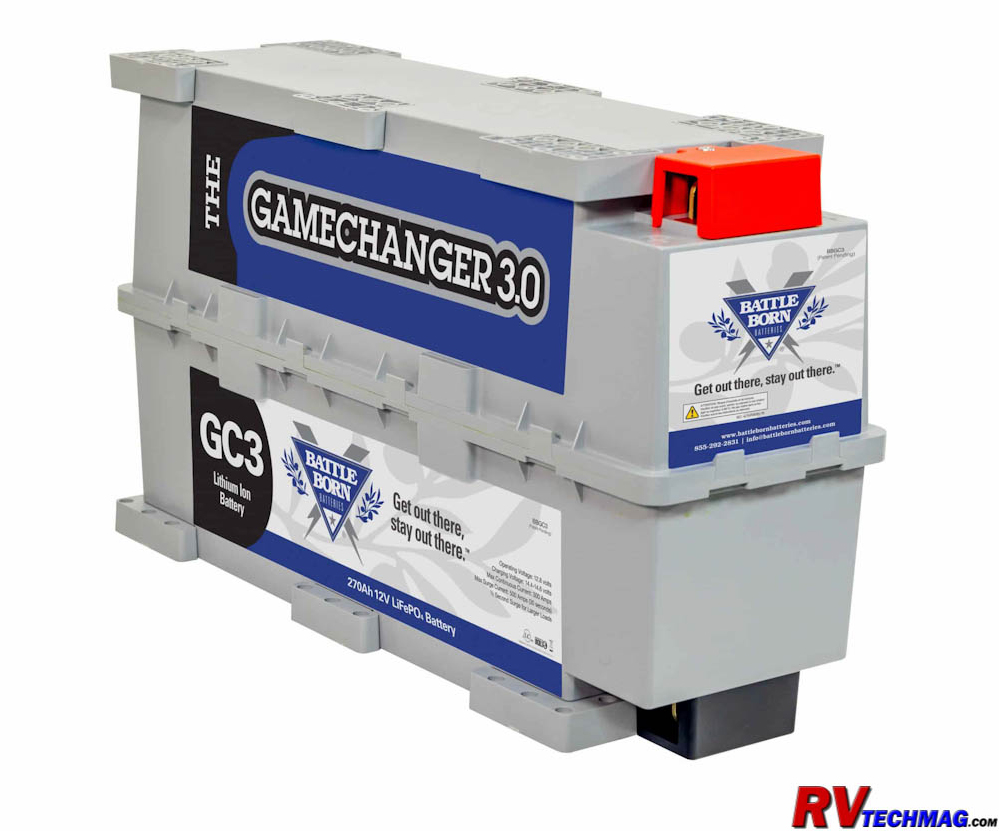
This 270 amp-hr battery is designed to fit into the same space as a pair of 6 volt golf cart style batteries.
|
Effects of Temperature
Any battery doesn't perform well in cold weather but lithium batteries are more sensitive to both cold and extreme hot
temperatures. A lithium battery may specify a discharge temperature of between -4 degrees and 135 degrees. The ambient battery charging temperatures
may be above 26 degrees and less than 115 degrees. For cold weather operation battery heaters are used. Many batteries, such as the Battle Born brand,
have built-in battery heaters that allow them to be used in cold weather that are managed by an internal Battery Management System (BMS) that
will protect the battery from extreme temperatures. A BMS will also prevent excess voltage or current from damaging the battery by shutting it off.
Charging Concerns
While a lithium battery with BMS will protect the battery from overcharging, it still won't be able to allow your battery to be
properly charged. Lead-acid batteries have different charge profile than lithium batteries. A lead-acid battery may require a 14.4 volt bulk charge and
a 13.2 volt float charge while a lithium battery may require 14.6 volts bulk and 13.6 volts float. If you are charging your battery bank with an
inverter-charger the odds are good that you will be able to configure the bulk,
absorption and float charge levels via their setup menu so that you can
recharge them up to 100%. If you have an older inverter-charger or a converter that does not provide that ability you
may need to replace it with a
newer upgraded model. If your RV is equipped with solar panels you will need to ensure that your solar panel array's charge controller has the ability to
set these same voltages that will work with lithium batteries.
A motorhome will also charge your lithium house batteries while driving via the engine's alternator. However, the alternator
was designed to charge the chassis starting battery. After an initial startup you will see the voltage climb to a high level, then gradually taper off as
the engine's starting battery receives its charge. You'll need to protect your lithium batteries from any overvoltage charge. Batteries with an internal
BMS can protect them but you still may not get a full charge without some sort of external management. That's where a Battery Isolation Manager (BIM) is
an important component on any motorized RV with lithium batteries. The BIM will monitor incoming voltage from the alternator as well as the current voltage
in the lithium battery bank. If the battery bank exceeds 13.4 volts the BIM will disconnect the batteries from any incoming
charge power. It will also
monitor voltage scenarios and allow timed charge cycles to protect
the batteries as well as the engine alternator under every situation. A lithium battery
can accept a charge approximately five times faster than a lead-acid battery which can put a lot of stress on an alternator. A BIM will allow the
alternator rest in between timed cycles to prevent alternator failure. These units are
sometimes referred to as DC to DC Chargers.
|

A popular DC/DC charger from Victron for a small battery bank.
|
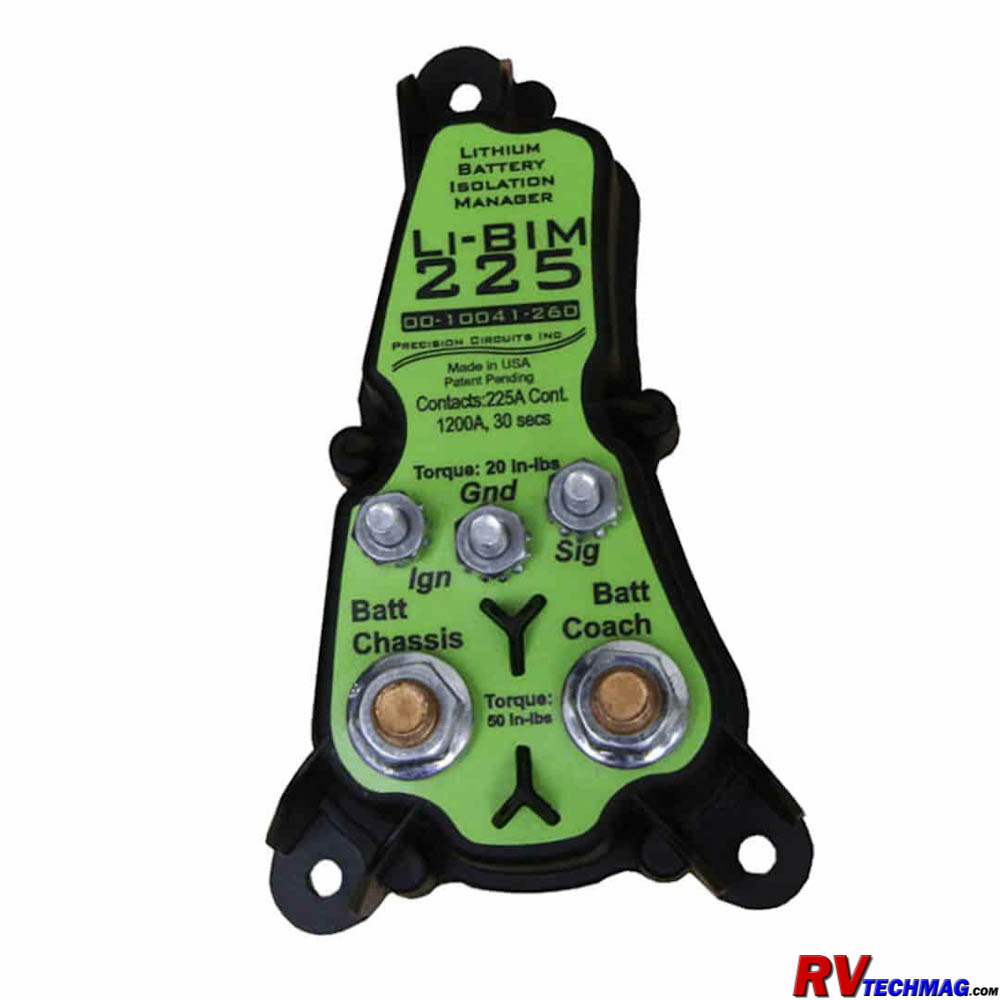
A BIM is commonly used on battery banks with three or more batteries.
|
The state of charge for lead-acid batteries can easily be done by comparing their at-rest voltage with a chart. While lead-acid
batteries show a full charge at 12.6 volts, lithium batteries will be fully charged at 13.4 volts. The best way to correctly identify the state of charge
for lithium batteries is by using a shunt based battery monitor, such as those made by Victron, that will monitor all current in and out of the battery.
In some cases your batteries might even be equipped with internal Bluetooth capability so that you can use your smart phone to communicate directly to
the batteries to determine their state of charge.
Lithium batteries may be a pricey upgrade but the benefits of longevity and the ability to use
less batteries to deliver the same
amp-hour capacity help to balance the initial cost to an extent. If you can utilize the additional capacity it may be a worthy upgrade. If so, you'll need
to carefully review your current system to ensure that your inverter/charger or converter is capable of charging a lithium battery bank, whether the
batteries you've selected are equipped with an internal battery
management system, whether you need heated batteries and whether or not you need a BIM on
your RV. Once you've done that research you'll be able to make an informed decision for your needs and be able to justify the cost.
Return to Home Page
If you enjoyed this article be sure to recommend RVtechMag.com to your friends, like us on Facebook or Twitter
or subscribe to our RSS feed.



|













